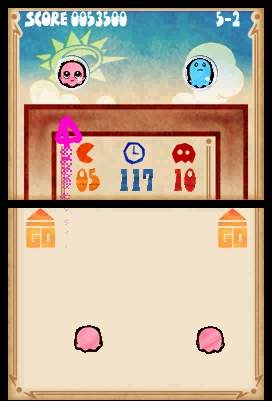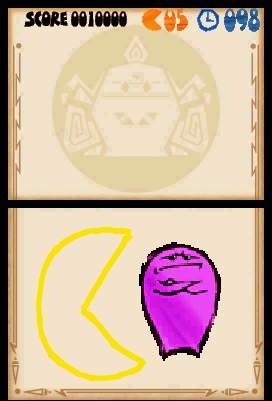There's a really neat concept at work in Namco's Pac-Pix for the Nintendo DS. Drawing Pac-Men on the DS screen and seeing your horrific mutant Pac-Creations come to life and chomp around the screen is really cool. Unfortunately, the quest to turn what started life as a tech demo into a full-fledged game has not gone well. You'll probably dig on the game's unique concept, but when it comes to playing Pac-Pix, that concept gets old real fast.

The story touches on weird stuff like ghost ink, Pac-Man getting trapped in a book, and magic pens. But here's what you really need to know. In Pac-Pix, you'll draw the outline of a Pac-Man on the DS touch screen, and then it will come to life and start moving, eating anything in his path. You can draw walls to change the Pac-Man's directions, and your goal is to eat a specific number of ghosts before a time limit expires. You'll also have a limited number of Pac-Men at your disposal, so using walls to keep your Pac-Men onscreen and active is key to a quick success. As you proceed, you'll encounter a few bosses and stumble onto some slightly trickier puzzles. You'll also gain access to additional drawings that will be key to puzzle-solving. Drawing an arrow will fire arrow-shaped missiles up at the top screen, where you can pop bubbles to bring ghosts down to Pac-Man's level, and you'll also be able to draw bombs and attach their fuses to candles when you need to blow something up. Again, this all functions on a conceptual level, but due to the almost immediate repetition, you'll get interested only when the game throws something new at you, which doesn't happen often.
For the most part, you're just drawing a couple of Pac-Man shapes and guiding them around the screen as they gobble everything up. As mentioned, the game occasionally tosses a boss fight at you, which makes for a nice change of pace, though these are rarely difficult. There are 12 levels, and each one is broken up into a handful of stages. If you run out of Pac-Men, or if time expires on any of these stages, you'll have to start the whole series over. This makes losing a boss fight fairly troublesome, since you'll have to trudge through five stages of ghost eating to get a second chance.
Graphically, Pac-Pix achieves the intended look of a book that's been overrun by ghosts. The ghosts are small, and though they don't animate very much, they have a nice, cartoony look to them. The rest of the graphics, really, are the ones that you're going to draw yourself. The look of the game is probably one of its strongest features, as it's kind of entertaining to draw crazy, deformed Pac-Man shapes and watch them spring to life and animate around the screen, horrific overbites and all. At the same time, the booklike treatment means that the backgrounds are all blank parchment, which isn't terribly inviting.

Much of the soundtrack consists of remixes of the little bits of music found in the old Pac-Man games, which does well to give the game a decidedly Pac-Man feel. The sound effects are similar in that they're updates to many of the sound effects you've come to expect from a Pac-Man game. Overall, the presentation is functional, but it isn't exactly reaching for the stars, either. Aside from the wacky shapes you'll be drawing, it all looks awfully plain.
Pac-Pix started as a tech demo, and the final product doesn't really stray too far from its roots. The core idea is very cool and unlike anything else on the market. Unfortunately, the game wrapped around that idea isn't nearly as inventive. If you have the opportunity to try Pac-Pix, you should definitely mess around with it. But that doesn't mean that it's worth $29.99.